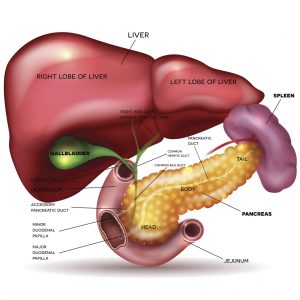Pancreatic Neuroendocrine Tumors
Home » For Patients old » NET Tests & Treatments » NET Sites » Pancreas
About 12% of neuroendocrine tumors occur in the pancreas.5 Pancreatic neuroendocrine tumors (sometimes called pNET) may not cause any signs or symptoms. Most pNETs do not appear to be inherited or passed down, but some risk factors can run in families, such as a syndrome called multiple endocrine neoplasia type I (MEN 1).
Where is the pancreas?
The pancreas is in the upper abdomen behind the stomach. It has two important functions:
- Exocrine cells produce enzymes that break down food in the small intestine.
- Endocrine cells produce hormones that regulate blood sugar, the movement of the gut, and acid production.
Pancreatic neuroendocrine tumor symptoms
When a healthy endocrine cell becomes cancerous, it may overproduce hormones, causing a range of symptoms, depending on the hormone6, such as:
- Diarrhea
- Flushing of the skin and face (without sweating)
Skin rash - Hypoglycemia (low blood sugar) or hyperglycemia (high blood sugar)
- Pain
- Digestive problems
- Gallbladder problems
- Changes in weight
Functional vs. non-functional pancreatic neuroendocrine tumors
Functional pancreatic neuroendocrine tumors
Functional pancreatic neuroendocrine tumors, depending on the endocrine cells of origin, can overproduce and release large amounts of hormones into the bloodstream.7
When a pNET releases hormones, it may be named after the hormone it produces:6
- Ιnsulιnoma
- Glucagonoma
- Gastrinoma
- VIPoma
- Somatostatinoma
Risk factors for pancreatic neuroendocrine tumors
A few different syndromes can increase a person’s risk of developing pancreatic neuroendocrine tumors:6
- Multiple Endocrine Neoplasia Type 1 (MEN1)
- Von Hippel-Lindau Disease (VHL)
- Tuberous Sclerosis Complex
- Neurofibromatosis Type 1 (NF1)
Having one of these risk factors does not mean you will develop a NET, it only increases the likelihood.
Non-functional pancreatic neuroendocrine tumors
Non-functional pancreatic neuroendocrine tumors do not overproduce and secrete hormones into the bloodstream. Non-functional pancreatic neuroendocrine tumors can sometimes grow for a long time without causing signs or symptoms. Then the size of may cause signs or symptoms, such as:6
- Diarrhea
- Indigestion
- A lump in the abdomen
- Pain in the abdomen or back.
- Jaundice if the bile duct is blocked (Yellowing of the skin and whites of the eye)
Testing can help determine whether a tumor is functional or nonfunctional.

Matthew Kulke, MD, Boston Medical Center
What is a pancreatic NET? Watch Video
Pamela Kunz, MD
Pancreatic NETS Watch Video
Matt Katz, MD, MD Anderson Cancer Center
Surgery for pancreas and small bowel Watch Video
Heloisa Soares, MD, PhD
Functional v. Nonfunctional NETs Watch VideoWhat is the difference between a pancreatic neuroendocrine tumor and a pancreatic tumor?
Though they occur in the same organ, these are two different types of cancers.
Pancreatic adenocarcinoma and neuroendocrine cancers have different:
- Causes
- Symptoms
- Tests
- Treatments
Pancreatic adenocarcinoma
Starts in the exocrine cells:
- More common
- Poorer chance of recovery
Pancreatic neuroendocrine cancer
Starts in the endocrine cells:
- Less common
- Better chance of recovery
5Frilling A, Akerström G, Falconi M, et al. Neuroendocrine tumor disease: an evolving landscape. Endocrine-Related Cancer. Endocr-Rel Caner. 2012;19(5):163-185.
6Cancer.NET Editorial Board. Neuroendocrine Tumor of the Pancreas: Symptoms and Signs. 2017. https://www.cancer.net/cancer-types/neuroendocrine-tumor-pancreas/symptoms-and-signs. Accessed October 22, 2018.
7National Cancer Institute. Pancreatic Neuroendocrine Tumors (Islet Cell Tumors) Treatment (PDQ®)-Patient Version. 2018. https://www.cancer.gov/types/pancreatic/patient/pnet-treatment-pdq. Accessed October 22, 2018.

